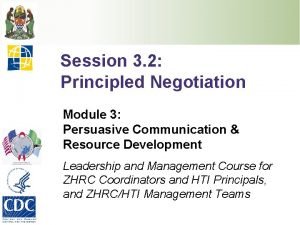Principled Negotiation 4 Scholars from the Harvard Negotiation











- Slides: 11

Principled Negotiation 4 Scholars from the Harvard Negotiation Project have suggested ways of dealing with negotiation from a cooperative and interestbased perspective. They call this approach “principled negotiation” because it rests on four assumptions or principles. Tricia S. Jones, Temple University, copyright protect, March 2006

Separate the People From the Problem 4 As you identify the problem, make sure you can distinguish between the issues to be solved and the people involved. Try to: – understand their perceptions – monitor their emotions – communicate effectively Tricia S. Jones, Temple University, copyright protect, March 2006

Focus on Interests NOT Positions 4 A position is a tangible outcome that someone argues for. An interest is the reason why that outcome is desired an underlying concern about the problem. • there are usually multiple interests for any issue • you don’t have to have common interests to find a solution that meets them all • the more you understand your interests and the other party’s interests, the better able you are to find a solution or solutions that will produce mutual and Tricia S. Jones, Temple University, copyright protect, March 2006 lasting satisfaction.

Invent Options for Mutual Gain - Brainstorm 4 This is a process of creating as many solutions as possible BEFORE you evaluate them to decide which are the best options. 4 Otherwise, good ideas never have a chance to be suggested and discussed because people are too busy arguing over the first ideas introduced. Tricia S. Jones, Temple University, copyright protect, March 2006

Find Good Criteria 4 Choosing a good solution or solutions (remember you can have more than one), depends on making sure that the criteria for solutions are considered legitimate by the parties. The criteria come from – interests already identified by the parties, especially common interests shared by all parties – external rules or policies that must be followed Tricia S. Jones, Temple University, copyright protect, March 2006

Pre-Negotiation Preparation 4 Describe the Problem – you define? – they define? – assumptions? 4 Identify Interests – your interests? – their interests? – assumptions? Tricia S. Jones, Temple University, copyright protect, March 2006

Negotiation 4 clarify the problem 4 explore interests 4 brainstorm 4 establish criteria 4 select options Tricia S. Jones, Temple University, copyright protect, March 2006

Clarify the Problem – your description – their description – if your descriptions are not the same? – – commonalities? if not, importance to the parties? logical reason to address one issue first? Construct an agenda for dealing with multiple issues. Tricia S. Jones, Temple University, copyright protect, March 2006

Explore Interests – Present Interests – State interests clearly – Clarify interests – Summarize Interests – Draw Attention to Common Interests Tricia S. Jones, Temple University, copyright protect, March 2006

Invent Options for Mutual Gain (Brainstorm) – Present the idea of brainstorming (generate ideas without evaluation) – Generate Ideas – Clarify Ideas – Summarize Options Generated – Get Agreement on the List of Options Tricia S. Jones, Temple University, copyright protect, March 2006

Establish Criteria – Explicitly State Criteria – Clarify Criteria – Prioritize Criteria (individually and jointly) – Select Preferred Negotiated Solution – Evaluate each Option with Criteria – Identify Preferred or Workable Options Tricia S. Jones, Temple University, copyright protect, March 2006



















